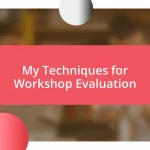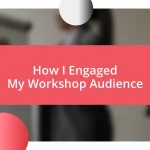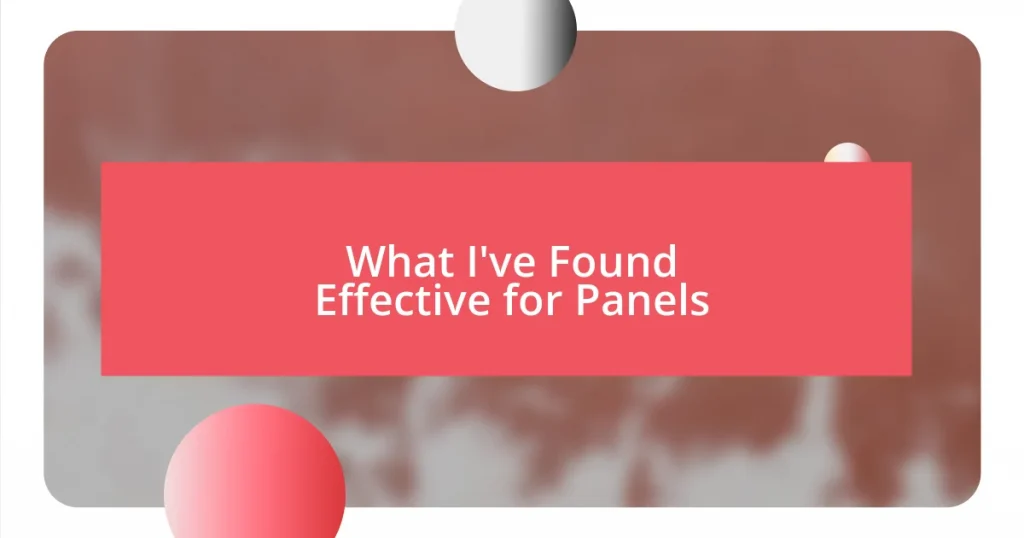Key takeaways:
- Understanding audience needs through informal surveys and conversations enhances workshop content relevance and engagement.
- Defining clear, SMART learning outcomes provides participants with a focused learning roadmap, increasing satisfaction and actionable skills.
- Continuous evaluation and feedback collection from participants after workshops improve future sessions and foster collaborative learning experiences.

Understanding Your Audience Needs
Understanding your audience’s needs is crucial to creating workshop content that truly resonates. I remember when I first started out, my workshops seemed to fall flat because I hadn’t taken the time to dig into what attendees were genuinely interested in. It was an eye-opener for me when a participant candidly mentioned, “This isn’t what I expected.” That moment sparked a transformation in my approach.
I began conducting informal surveys and chatting with potential attendees about their expectations. This not only gave me insights into their pain points but also made them feel valued and heard. Isn’t it fascinating how a simple conversation can unveil layers of understanding? Diving into the emotions and challenges of my audience has not only enriched my content but has also fostered a deeper connection during the workshops.
When I design content now, I constantly ask myself, “What do they really want to learn?” This question serves as my North Star, guiding me to create workshops that address real needs rather than what I think they need. The impact is tangible; when participants feel engaged and understood, I can see their enthusiasm grow, transforming the workshop into an enriching experience for everyone involved.

Defining Clear Learning Outcomes
Defining clear learning outcomes is essential for effective workshop planning. When I first started, I would create content based on what I thought was important, only to realize later that clarity was lacking. I remember sifting through feedback forms that often mentioned, “I wanted clearer goals.” This realization pushed me to rethink how I articulated what participants would gain, making outcomes explicit and achievable.
To craft impactful learning outcomes, I began employing the SMART criteria – Specific, Measurable, Achievable, Relevant, and Time-bound. This structured approach not only keeps my sessions focused but also provides participants with a roadmap for their learning journey. I once listed an outcome as “understanding conflict resolution” without specifying what that meant. After redefining it as “identifying three conflict resolution strategies and practicing them in pairs,” feedback was overwhelmingly positive. Participants felt they had concrete skills to apply immediately.
Additionally, sharing these outcomes at the beginning of the workshop fosters excitement. It gives everyone a sense of direction and paves the way for deeper engagement. I often recount how I witnessed a group’s energy shift when they realized they would leave with actionable tools. This not only enhances learning but also instills confidence, a key component for success in any workshop.
| Traditional Approach | Clear Learning Outcomes |
|---|---|
| Lacks Clarity | Specific and Focused |
| Participants Feel Lost | Guides Learning Journey |
| General Goals | SMART Goals |
| No Real Application | Actionable Skills |

Structuring Engaging Workshop Activities
Structuring engaging workshop activities is all about striking the right balance between creativity and organization. I’ve found that infusing energy into these activities makes them not only more enjoyable but also more effective. Once, while facilitating a workshop on team building, I introduced a spontaneous role-playing exercise. The room lit up with laughter and genuine engagement, turning a mundane topic into an animated discussion. This taught me that sometimes, the best ideas come from allowing flexibility within the structure.
When planning these activities, I keep a few key principles in mind:
- Variety: Incorporate different types of activities such as group discussions, hands-on tasks, or reflective moments to cater to diverse learning styles.
- Collaboration: Encourage teamwork through pair or group activities, fostering a sense of community and shared learning.
- Real-world Application: Ensure activities are relevant to participants’ experiences, helping them see the direct benefits.
- Create a Comfortable Atmosphere: Begin with icebreakers or light energizers to reduce tension and build rapport.
- Feedback Loop: Incorporate mechanisms for real-time feedback, allowing for adjustments along the way.
By embracing these strategies, I’ve observed how they lead to deeper connections and richer learning experiences. Engaging workshop activities, when thoughtfully structured, can transform passive listeners into active participants, all while fostering a supportive environment that feels both safe and stimulating.

Incorporating Interactive Elements Effectively
Incorporating interactive elements effectively can transform a standard workshop into an immersive experience. I remember a session where I introduced an interactive poll using live technology. It not only spurred instant engagement but also provided me with valuable insights into participants’ perspectives. Seeing those real-time responses on the screen was eye-opening; it made the content feel relevant and gave everyone a voice. Have you felt that shift when you see your audience actively participating? It creates an electric atmosphere that enhances retention and comfort.
Another method that has worked wonders for me is including breakout sessions. During a particularly memorable workshop on leadership, I divided participants into small groups to brainstorm solutions to common challenges. Watching them collaborate and bounce ideas off each other reminded me of how powerful shared experiences can be. Those intimate discussions offered a safe space for vulnerability, and the group collectively developed solutions that individuals might not have conceived alone. How often do we miss out on collaborative benefits in larger settings?
Lastly, using storytelling as an interactive element can really resonate. I once shared a personal story about overcoming a significant challenge, and I prompted participants to reflect on their similar experiences. The room shifted as everyone connected through shared vulnerabilities. This approach not only fosters empathy but also encourages participants to engage deeper and share their own narratives, enhancing the overall learning experience. Aren’t you curious about how a simple story can weave a tapestry of connection among strangers?

Utilizing Visual Aids and Materials
Visual aids and materials can elevate the overall impact of a workshop significantly. I vividly recall a time when I used an oversized visual timeline to illustrate the evolution of a concept. As I walked through each pivotal moment, the audience’s eyes lit up with recognition and curiosity. It reminded me how much clarity and engagement a simple visual can bring to complex ideas. Have you noticed how a well-placed image or graphic can shift attention and spark discussion?
In another instance, I decided to utilize infographics during a presentation on project management. Participants seemed more engaged, remembering information more easily as they connected visually with the content. I also handed out interactive handouts that encouraged participants to jot down their thoughts and questions. This approach not only kept everyone focused but also made the materials memorable. Reflecting on this, it seems clear to me that visuals do more than just convey information—they create a conversation starter.
Lastly, I’ve found that incorporating videos can enhance storytelling in workshops. During a recent session on innovation, I shared a short, inspiring clip that showcased real-life success stories. The emotional resonance in the room was palpable, as participants began to share their own ideas inspired by the visuals. It’s fascinating how a well-chosen clip can not only capture attention but also infuse energy into discussions. Have you ever noticed how visuals can open the floodgates of creativity among participants?

Evaluating and Refining Workshop Content
Evaluating and refining workshop content is a continuous journey that requires me to gather honest feedback. I often use post-workshop surveys to understand participants’ experiences. Recently, after a session on effective communication, I was surprised to discover that while many loved the theory, they craved more practical exercises. Reflecting on this, I realized how critical it is to listen and adapt based on real participant needs.
In my experience, peer reviews also play a vital role in refining content. I remember inviting a colleague to attend my workshop as a silent observer. Afterward, they provided insights that I hadn’t considered, such as pacing and clarity. This external perspective was invaluable; it drove home the idea that sometimes we are too close to our material to see its full impact. Have you ever had a moment like that where a fresh set of eyes made everything clearer?
Finally, I find iterative revisions essential. After implementing feedback from surveys and peer reviews, I conduct trial runs with smaller groups. During one of these sessions, I adjusted my content on the fly based on participants’ reactions. Their laughter and nods guided me, showing when to elaborate and when to simplify. The satisfaction I felt from these adjustments reinforced the importance of flexibility. Aren’t these small tweaks pivotal in shaping an audience’s understanding and engagement?

Gathering Feedback After the Workshop
Collecting feedback after a workshop is a crucial step that I prioritize to enhance future sessions. I remember a particularly enlightening moment after a workshop on leadership styles. Participants were asked to provide their thoughts via anonymous sticky notes. The variety of comments ranged from praise for the interactive elements to requests for more case studies. The diversity of feedback reminded me how essential it is to create an open environment for sharing, as not everyone feels comfortable expressing their thoughts aloud.
Surveys have become my go-to method for gathering insights following my workshops. After a recent session focusing on personal branding, I used a simple online form, carefully crafting questions that encouraged detailed responses. One respondent highlighted how an interactive element sparked their introspection, while another pointed out moments where they felt lost. I cherish these insights; they allow me to pinpoint exactly where adjustments are needed and validate what’s working well. Have you ever noticed how the simplest survey can yield profound revelations?
In my experience, follow-up conversations can deepen the feedback process. For instance, after a workshop on conflict resolution, I opted to reach out personally to a few participants. I was amazed to hear their stories about applying the techniques we discussed. Their enthusiasm and insights not only reinvigorated my passion for the topic but also provided me with concrete examples to share in future sessions. Isn’t it incredible how these dialogues can transform mere feedback into a collaborative learning experience?















